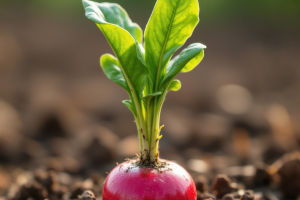I once left my Bluetooth speaker playing soft jazz in the kitchen overnight. The next morning, I found my little basil plant noticeably perkier than usual. Coincidence? Maybe. But it got me wondering—can music actually affect how plants grow?
Turns out, this question isn't new. For decades, scientists, students, and curious gardeners have been experimenting with sound and seedlings.
And while the results aren't always consistent, some patterns have emerged that are both fascinating and surprisingly practical.
Let's explore what music does to plants—and what doesn't work at all.
Why Even Study This?
Plants don't have ears. So why would music matter?
While they can't hear the way we do, plants can detect and respond to vibrations. Sound waves are vibrations moving through air—and if those waves reach a plant's cells or tissues, they can influence how the plant behaves.
Some scientists believe these vibrations may trigger changes at the cellular level, potentially affecting growth hormones, nutrient absorption, or gene expression. Others argue that it's just mechanical stimulation—like wind or touch.
In other words, music might be a kind of gentle signal, like a breeze with a rhythm.
Experiments That Went Beyond the Greenhouse
Let's look at a few well-documented experiments that tested the plant-music relationship in controlled environments.
1. The Dorothy Retallack Experiments (1973)
One of the earliest and most widely cited studies comes from Dorothy Retallack at the Colorado Women's College. She placed plants in separate soundproof chambers and played different genres of music for several hours a day.
• Plants exposed to classical music leaned toward the speaker and grew bushier.
• Those subjected to rock or heavy metal actually shriveled and turned away from the sound source.
• One group exposed to constant rock music died within two weeks.
Her findings sparked decades of debate, but they laid the groundwork for future studies. Some critics point out her sample sizes were small, but the directional growth toward soft music was replicated by others later on.
2. South Korean Research on Frequencies (2007)
Researchers at the National Institute of Agricultural Biotechnology studied rice plants by exposing them to varying frequencies of sound.
• Frequencies between 125 Hz and 250 Hz had a notable positive effect on plant growth.
• Plants exposed to those low frequencies showed higher levels of growth-related genes.
This suggests that certain frequencies—not just musical genres—might influence how plants grow, regardless of melody or harmony.
3. University of Florence Study on Tomatoes (2015)
In this study, tomato plants were exposed to classical music for 6 hours a day during their flowering phase.
• Result: Faster flowering and more robust fruit production compared to the control group.
• Classical pieces with string-heavy arrangements seemed to have the greatest effect.
Even more interesting: they also observed fewer pests on the musically exposed plants—suggesting sound may influence more than just internal biology.
What Music (and Sounds) Might Work
Based on multiple studies, here are a few types of sound that seem to help plants:
1. Classical music
Think Mozart, Bach, or Vivaldi. Complex harmonies and smooth string vibrations appear to have a calming, growth-promoting effect.
2. Nature sounds
Gentle wind, rainfall, or birdsong—when played at low volume—can mimic a healthy outdoor environment and reduce plant stress indoors.
3. Low-frequency tones (125–250 Hz)
These frequencies may stimulate biological activity even without traditional melody. You can find these on YouTube under “low-frequency plant growth music.”
4. Instrumental ambient music
Music with no lyrics, slow tempo, and consistent rhythm seems to be well-received (by plants and humans alike).
What doesn't work?
• Loud, erratic noise like metal or industrial sounds.
• Human voice recordings or spoken podcasts—these don't seem to influence plant growth one way or another.
• Silence isn't harmful, but in some tests, plants exposed to beneficial sounds grew faster than those left in silence.
Tips If You Want to Try This at Home
Curious to see if your plants are music lovers? Here's how to set up your own simple experiment:
1. Pick two or more similar plants
Use the same type, size, and soil to keep conditions even.
2. Choose your music
Select one plant to receive music exposure and one as the control. Play music for about 2–3 hours per day at a moderate volume.
3. Track results weekly
Measure height, number of leaves, and overall color or health. Take photos for comparison.
4. Be consistent
Keep lighting, watering, and temperature the same across all test plants.
It's not a lab, but it can be surprisingly fun—and eye-opening.
So... Do Plants Have a Favorite Song?
We still don't know exactly how or why music affects plants, and not every study agrees. Some researchers argue that any benefits come from vibration alone—not music as we know it. Others believe music may impact soil microbes or humidity in subtle ways.
But one thing is clear: under the right conditions, certain sounds can support plant growth—and definitely won't hurt.
Even if your fern doesn't develop a taste for Bach, the act of slowing down, selecting a playlist, and being present with your plants is its own kind of nourishment.
Maybe the secret isn't whether plants can hear—but whether we can learn to listen differently.
Try putting on some gentle music next time you water your plants. Not to prove a point—but to enjoy the moment. That kind of care, felt or heard, always makes things grow.


